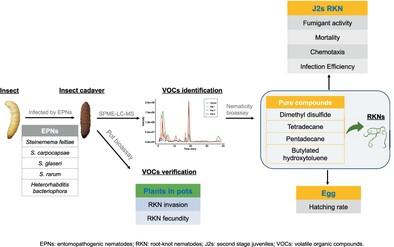当前位置:
X-MOL 学术
›
Pest Manag. Sci.
›
论文详情
Our official English website, www.x-mol.net, welcomes your feedback! (Note: you will need to create a separate account there.)
Volatile organic compounds released from entomopathogenic nematode‐infected insect cadavers for the biocontrol of Meloidogyne incognita
Pest Management Science ( IF 3.8 ) Pub Date : 2024-06-29 , DOI: 10.1002/ps.8268 Jingjing Li 1, 2 , Xianqin Wei 1 , Zixuan Pei 1 , Jie Sun 1 , Jiale Xi 1 , Xingyue Li 3 , David Shapiro‐IIan 4 , Weibin Ruan 1
Pest Management Science ( IF 3.8 ) Pub Date : 2024-06-29 , DOI: 10.1002/ps.8268 Jingjing Li 1, 2 , Xianqin Wei 1 , Zixuan Pei 1 , Jie Sun 1 , Jiale Xi 1 , Xingyue Li 3 , David Shapiro‐IIan 4 , Weibin Ruan 1
Affiliation

|
BACKGROUNDRoot‐knot nematodes (RKNs), Meloidogyne spp. , are one of the most destructive polyphagous plant‐parasitic nematodes. They pose a serious threat to global food security and are difficult to control. Entomopathogenic nematodes (EPNs) show promise in controlling RKNs. However, it remains unclear whether the volatile organic compounds (VOCs) emitted from EPN‐infected cadavers can control RKNs.RESULTSWe investigated the fumigation activity of VOCs released from cadavers infected by five different species of EPNs on RKNs in Petri dishes, and found that VOCs released from Steinernema feltiae (SN strain) and S. carpocapsae (All strain) infected cadavers had a significant lethal effect on second‐stage juveniles (J2s) of Meloidogyne incognita . The VOCs released from the cadavers infected with S. feltiae were analyzed using SPME‐GC/MS. Dimethyl disulfide (DMDS), tetradecane, pentadecane, and butylated hydroxytoluene (BHT), were selected for a validation experiment with pure compounds. The DMDS compound had significant nematicidal activity and repelled J2s. DMDS also inhibited egg hatching and the invasion of tomato roots by J2s. In a pot experiment, the addition of S. feltiae ‐infected cadavers and cadavers wrapped with a 400‐mesh nylon net also significantly reduced the population of RKNs in tomato roots after 7 days. The number of root knots and eggs was reduced by 58% and 74.34%, respectively, compared to the control.CONCLUSIONThese results suggested that the VOCs emitted by the EPN‐infected cadavers affected various developmental stages of M. incognita and thus have the potential to be used in controlling RKNs through multiple methods. © 2024 Society of Chemical Industry.
中文翻译:

昆虫病原线虫感染昆虫尸体释放的挥发性有机化合物用于生物防治南方根结线虫
背景根结线虫(RKNs),根结线虫属,是最具破坏性的多食性植物寄生线虫之一。它们对全球粮食安全构成严重威胁且难以控制。昆虫病原线虫 (EPN) 在控制 RKN 方面显示出希望。然而,目前尚不清楚感染 EPN 的尸体释放的挥发性有机化合物 (VOC) 是否可以控制 RKN。 结果我们研究了五种不同种类 EPN 感染的尸体释放的 VOC 对培养皿中 RKN 的熏蒸活性,发现 VOC从受感染的斯氏线虫(SN 株)和 S. carpocapsae(所有株)感染的尸体中释放出的病毒对南方根结线虫第二阶段幼虫(J2s)具有显着的致死作用。使用 SPME-GC/MS 分析了感染毛毡链球菌的尸体释放的 VOC。选择二甲基二硫醚 (DMDS)、十四烷、十五烷和丁基羟基甲苯 (BHT) 进行纯化合物的验证实验。 DMDS 化合物具有显着的杀线虫活性并能驱除 J2s。 DMDS 还抑制卵孵化和 J2s 对番茄根部的侵袭。在盆栽实验中,添加感染毛毡链球菌的尸体和用 400 目尼龙网包裹的尸体,7 天后也显着减少了番茄根中 RKN 的数量。与对照相比,根节和卵的数量分别减少了 58% 和 74.34%。结论这些结果表明,EPN 感染尸体排放的 VOC 影响了南方根结线虫的各个发育阶段,因此有可能通过多种方法用于控制 RKN。 © 2024 化学工业协会。
更新日期:2024-06-29
中文翻译:

昆虫病原线虫感染昆虫尸体释放的挥发性有机化合物用于生物防治南方根结线虫
背景根结线虫(RKNs),根结线虫属,是最具破坏性的多食性植物寄生线虫之一。它们对全球粮食安全构成严重威胁且难以控制。昆虫病原线虫 (EPN) 在控制 RKN 方面显示出希望。然而,目前尚不清楚感染 EPN 的尸体释放的挥发性有机化合物 (VOC) 是否可以控制 RKN。 结果我们研究了五种不同种类 EPN 感染的尸体释放的 VOC 对培养皿中 RKN 的熏蒸活性,发现 VOC从受感染的斯氏线虫(SN 株)和 S. carpocapsae(所有株)感染的尸体中释放出的病毒对南方根结线虫第二阶段幼虫(J2s)具有显着的致死作用。使用 SPME-GC/MS 分析了感染毛毡链球菌的尸体释放的 VOC。选择二甲基二硫醚 (DMDS)、十四烷、十五烷和丁基羟基甲苯 (BHT) 进行纯化合物的验证实验。 DMDS 化合物具有显着的杀线虫活性并能驱除 J2s。 DMDS 还抑制卵孵化和 J2s 对番茄根部的侵袭。在盆栽实验中,添加感染毛毡链球菌的尸体和用 400 目尼龙网包裹的尸体,7 天后也显着减少了番茄根中 RKN 的数量。与对照相比,根节和卵的数量分别减少了 58% 和 74.34%。结论这些结果表明,EPN 感染尸体排放的 VOC 影响了南方根结线虫的各个发育阶段,因此有可能通过多种方法用于控制 RKN。 © 2024 化学工业协会。











































 京公网安备 11010802027423号
京公网安备 11010802027423号